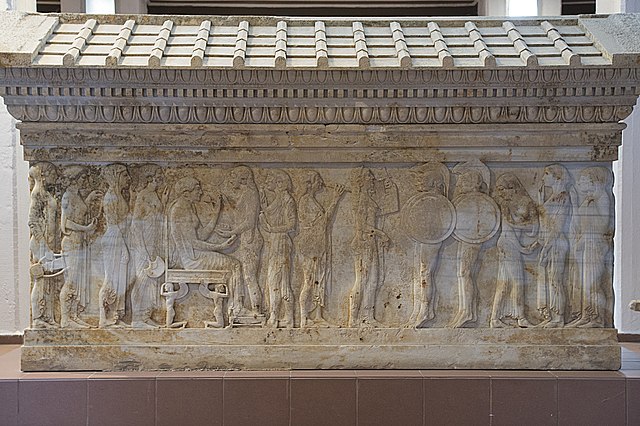In Greek mythology, Protesilaus was a hero in the Iliad who was venerated at cult sites in Thessaly and Thrace. Protesilaus was the son of Iphiclus, a "lord of many sheep"; as grandson of the eponymous Phylacos, he was the leader of the Phylaceans. Hyginus surmised that he was originally known as Iolaus—not to be confused with Iolaus, the nephew of Heracles—but was referred to as "Protesilaus" after being the first to leap ashore at Troy, and thus the first to die in the war.
Coinage of Skione. Head of Protesilaos, wearing Attic helmet / Stern of galley left within incuse square. Circa 480-470 BC
Coinage of Thebai, Thessaly. Veiled head of Demeter, wearing wreath of grain ears / ΘHBAIΩИ, Protesilaos, wearing armor and short chiton, holding sword in right hand and shield in left, stepping off the prow of a galley; waves visible to the lower right. Early 3rd century BC
The Trojan War was a legendary conflict in Greek mythology that took place around the 12th or 13th century BCE. The war was waged by the Achaeans (Greeks) against the city of Troy after Paris of Troy took Helen from her husband Menelaus, king of Sparta. The war is one of the most important events in Greek mythology, and it has been narrated through many works of Greek literature, most notably Homer's Iliad. The core of the Iliad describes a period of four days and two nights in the tenth year of the decade-long siege of Troy; the Odyssey describes the journey home of Odysseus, one of the war's heroes. Other parts of the war are described in a cycle of epic poems, which have survived through fragments. Episodes from the war provided material for Greek tragedy and other works of Greek literature, and for Roman poets including Virgil and Ovid.
The Golden Apple of Discord by Jacob Jordaens
The Burning of Troy (1759–1762), oil painting by Johann Georg Trautmann
Polyxena Sarcophagus in Troy Museum
The Judgement of Paris (1599) by Hendrick van Balen the Elder. Gemäldegalerie, Berlin






